March 3: Gainesville has many interesting attractions, but for us the best was meeting up with old friends from Cornell and Stanford.
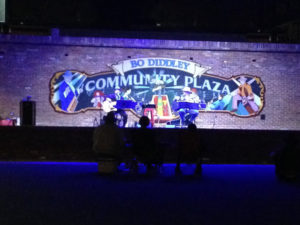 We spent the most time with our friend Anne who we knew for many years at Cornell. We always remember Anne as being outstandingly hospitable, and she continues in this mode. On Friday night we met her for dinner in downtown Gainesville (which I had never seen despite 2 previous visits to U Florida) after which we proceeded to Bo Diddley Square for a free outside concert. Since it was quite chilly, the crowd was a bit underwhelming, but we enjoyed the music.
We spent the most time with our friend Anne who we knew for many years at Cornell. We always remember Anne as being outstandingly hospitable, and she continues in this mode. On Friday night we met her for dinner in downtown Gainesville (which I had never seen despite 2 previous visits to U Florida) after which we proceeded to Bo Diddley Square for a free outside concert. Since it was quite chilly, the crowd was a bit underwhelming, but we enjoyed the music.
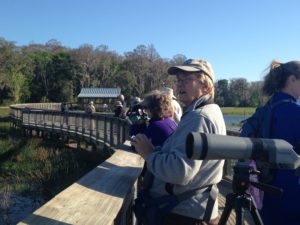 On Saturday morning, we joined Anne and her church group for bird walk in Sweetwater Wetlands Park. This area was reclaimed as a man-made wetlands to absorb nitrogen and release cleaner water to the Paynes Prairie State Park. It has become a major bird sanctuary.
On Saturday morning, we joined Anne and her church group for bird walk in Sweetwater Wetlands Park. This area was reclaimed as a man-made wetlands to absorb nitrogen and release cleaner water to the Paynes Prairie State Park. It has become a major bird sanctuary. 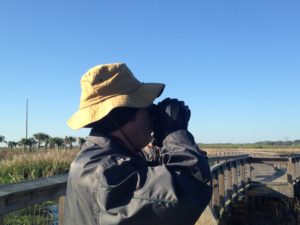 Armed with the best binoculars I have ever had the pleasure to use,(Anne’s spare pair) , Anne’s birding expertise and a small group of friendly folks, we headed off to see the most amazing collection of birds I have seen in the wild including (and I am not a birder, so this is not a full list): great blue herons, tricolored herons,
Armed with the best binoculars I have ever had the pleasure to use,(Anne’s spare pair) , Anne’s birding expertise and a small group of friendly folks, we headed off to see the most amazing collection of birds I have seen in the wild including (and I am not a birder, so this is not a full list): great blue herons, tricolored herons,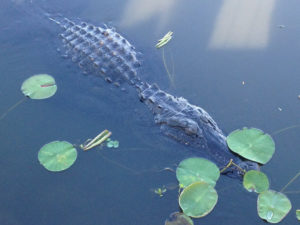 lesser blue herons, green herons, great egrets, lesser egrets, white ibis, glossy ibis, cormorants, anhingas, wood storks, bald eagle (2), ospreys, Sandhill cranes, a whooping crane (1), grackles, red-winged blackbirds, several species of swallows and of vultures.
lesser blue herons, green herons, great egrets, lesser egrets, white ibis, glossy ibis, cormorants, anhingas, wood storks, bald eagle (2), ospreys, Sandhill cranes, a whooping crane (1), grackles, red-winged blackbirds, several species of swallows and of vultures.
We also saw the largest alligator of our trip, which swam under the bridge you see behind Chuck.
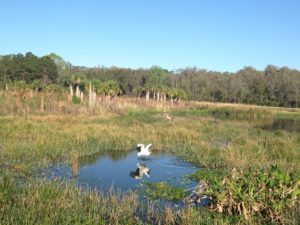 This large bird is a wood stork. I love this picture because you can see the distinctive black markings on the open wings from below as well as the view of the bird wading. There is also a great egret in the background.
This large bird is a wood stork. I love this picture because you can see the distinctive black markings on the open wings from below as well as the view of the bird wading. There is also a great egret in the background.
Whooping cranes are critically endangered with only a few hundred remaining in the wild. We were privileged to see a whooping crane up close when it chose to fly with 2 Sandhill cranes and land on the path only a few yards away. (Our phone cameras are not good enough to get a nice photo.) Our group was mesmerized for several minutes until a small group coming from the other direction literally walked into the 3 birds and scared them off. I can only guess that they had no idea what they were seeing. The cranes were lovely flying, too.
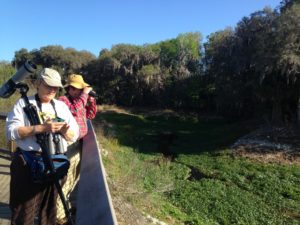
On Tuesday we went birding with Anne again on the Chua Trail at Payne Prairie State Park. This is quite the hike! For starters, the waterway at the edge of the trail is home to hundreds of large alligators. In the early morning, they are all basking on the banks – mostly on the other side, but a few under the ledge on the same side as the trail. 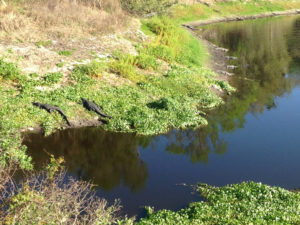 It is hard to believe that this habitat is rich enough to support this huge biomass of top predators. In this photo there are at least 8 large gators visible. This particular spot had at least 30 in the water or basking on the shore.
It is hard to believe that this habitat is rich enough to support this huge biomass of top predators. In this photo there are at least 8 large gators visible. This particular spot had at least 30 in the water or basking on the shore.
Again we saw a lot of big birds – particularly herons (great blue, lesser blue, tricolor and green), egrets, a stork, a couple of bald eagles, and of course lots of cormorants and anhingas.
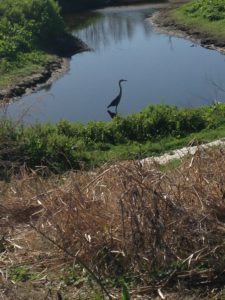
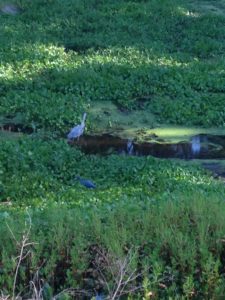
Anne was searching for a particular breed of sand plover that is rare in the area, but we did not sight it. We also learned a couple of new bird names, like yellow legs and glossy ibis, and Anne did see some birds rare in the area including an American pipit, a wild turkey and a peregrine falcon.
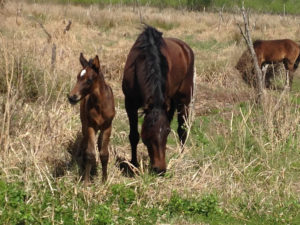
Paynes Prairie is also home to herds of wild horses, like this small group which kindly posed right beside the trail. There is also a herd of about 30 bison, which we could see further away. The bison have been proliferating too quickly, so the park removed all the males. Presumably at some point the herd will start to decline and new males will need to be brought in.
On Saturday after the hike, we went back to Gainesville for lunch with Hani and Deb, who I originally met while in grad school. Chuck had never met them, but we had a wonderful time together. It turns out that their son overlapped for a brief time at a company Jonathan worked for – although they had not met. As usual, I forgot to get a photo.
 After lunch we went to Alice Lake on the UFL campus, where I had seen alligators on previous visits. This lovely building is a chapel. A wedding was taking place.
After lunch we went to Alice Lake on the UFL campus, where I had seen alligators on previous visits. This lovely building is a chapel. A wedding was taking place.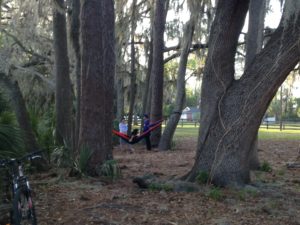
UFL students take advantage of the location to string up a hammock and read or socialize.
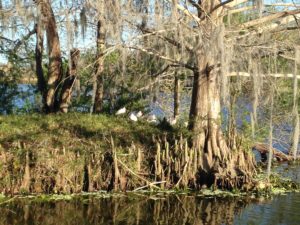 There was minimal gator activity on this trip, but huge numbers of big birds – principally greater egrets, great blue herons and anhingas, as well as the ibis in this picture – many of which were closer to the viewing area than at Sweetwater (although sadly I had returned the binoculars to Anne).
There was minimal gator activity on this trip, but huge numbers of big birds – principally greater egrets, great blue herons and anhingas, as well as the ibis in this picture – many of which were closer to the viewing area than at Sweetwater (although sadly I had returned the binoculars to Anne). 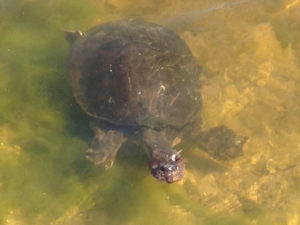 The lake aslo has many of these big turtles swimming close to shore. We wandered around the lake until dinner time at Anne’s, along with Cornell friends Jim and Maria.
The lake aslo has many of these big turtles swimming close to shore. We wandered around the lake until dinner time at Anne’s, along with Cornell friends Jim and Maria.
Among Anne’s many talents is cooking for a crowd. (If you are going to be as hospitable as she always is, this is a good talent to have). She had prepared 4 half-pizzas with hand-made dough and various interesting toppings. Jim and Maria brought appetizers and a home-made lemon pie. We had no problem in over-indulging! We caught up, reminisced and so on until quite late. Again – I forgot to get a photo!
 On Sunday afternoon we went to Kanapaha Botanical Gardens with Deb. This is a lovely garden – particularly the plantings of many types of bamboo.
On Sunday afternoon we went to Kanapaha Botanical Gardens with Deb. This is a lovely garden – particularly the plantings of many types of bamboo. 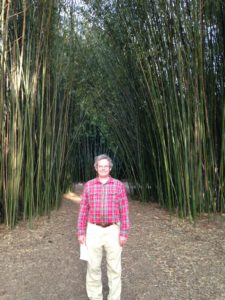
We were not quite in season for many of the flowering plants, but there were still plenty of beautiful flowers and lovely settings. 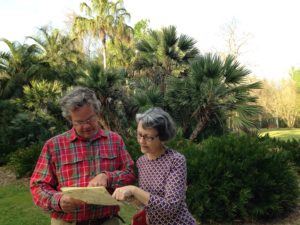
We kept our eyes open for gators in the many streams and ponds, but we did not see any. However, later Anne told us that the curator lost his arm to an alligator when he reached down to pick up some garbage without noticing the gator.
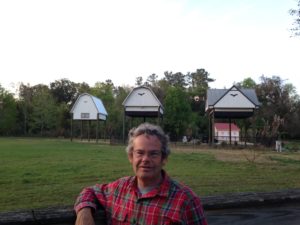 In the evening we returned to campus to watch the flight of the bats from the campus bat houses. There are about 250,000 bats in the houses. They eat about 2.5 billion insects nightly which is about 2500 pounds of insects. We’ve got to say that our walk around Alice Lake during the day was pleasantly insect-free. Just before dusk, however, the air was buzzing with bugs.
In the evening we returned to campus to watch the flight of the bats from the campus bat houses. There are about 250,000 bats in the houses. They eat about 2.5 billion insects nightly which is about 2500 pounds of insects. We’ve got to say that our walk around Alice Lake during the day was pleasantly insect-free. Just before dusk, however, the air was buzzing with bugs.
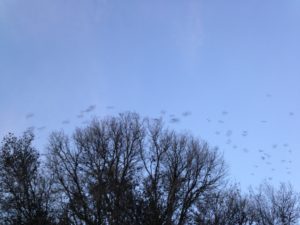 We are pretty sure that we saw at most a few thousand bats, but it was still an incredible sight, with a stream of bats emerging for about 30 minutes from 2 of the 3 houses in irregular bursts, on a path that brought them swooping over around a tree and over the lake. An enterprising red-shouldered hawk was waiting by the houses and clearly thought he was at a snack table. He grabbed one bat as it launched from the bat house and took it to a nearby tree to eat. He then sat in the stream of bats until he identified another victim which was also devoured in the tree.
We are pretty sure that we saw at most a few thousand bats, but it was still an incredible sight, with a stream of bats emerging for about 30 minutes from 2 of the 3 houses in irregular bursts, on a path that brought them swooping over around a tree and over the lake. An enterprising red-shouldered hawk was waiting by the houses and clearly thought he was at a snack table. He grabbed one bat as it launched from the bat house and took it to a nearby tree to eat. He then sat in the stream of bats until he identified another victim which was also devoured in the tree.
The bats feed only when it is above 65F. We were a few degrees short of that, so I hope that the reason we saw so few bats was the temperature. White nose syndrome is a serious fungal disease that is decimating the North American bat populations, but it is not yet found in Florida. Apparently there is a webcam in the bat house, so the estimated population of 250 thousand is likely accurate.
Anne convinced us that we need good binoculars (and probably a good bird book, too). Who knows, we might become birders!
Thank you all our Gainesville friends.
